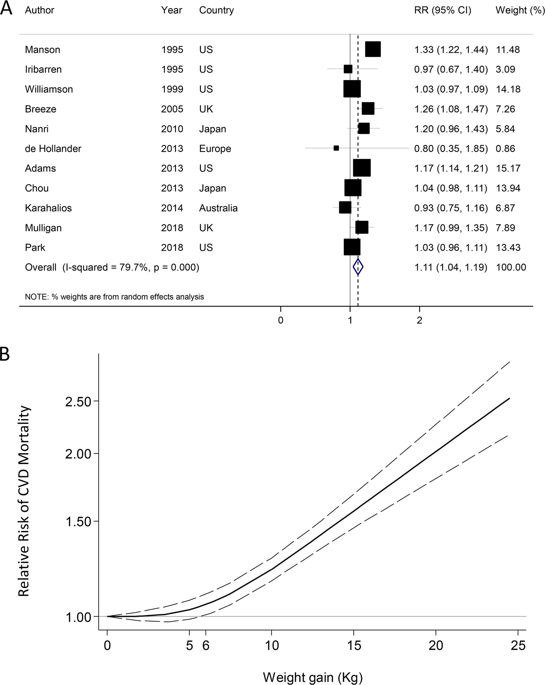European Journal of Clinical Nutrition ( IF 4.7 ) Pub Date : 2020-03-18 , DOI: 10.1038/s41430-020-0610-y Ahmad Jayedi 1, 2 , Ali Rashidy-Pour 3 , Sepideh Soltani 4 , Mahdieh Sadat Zargar 5 , Alireza Emadi 6 , Sakineh Shab-Bidar 2

|
We aimed to examine the association of weight gain during adulthood with the risk of cardiovascular disease (CVD) in the general population. We performed a systematic search of PubMed and Scopus, from inception to June 2019. Prospective cohort studies investigating the association of weight gain during adulthood with the risk of CVD were included. The relative risks (RRs) were calculated by using random-effect models. Twenty-three prospective cohort studies with 1,093,337 participants were included. The RRs for a 5-kg increment in body weight were 1.11 (95% CI: 1.04, 1.19; I2 = 80%, n = 11) for CVD mortality, 1.18 (95% CI: 1.04, 1.32; I2 = 90%, n = 8) for coronary heart disease (CHD), 1.08 (95% CI: 1.04, 1.12; I2 = 0%, n = 3) for stroke, 1.18 (95% CI: 1.12, 1.25; I2 = 0%, n = 2) for myocardial infarction and 1.05 (95% CI: 0.86, 1.23; I2 = 80%, n = 2) for heart failure. A dose–response analysis demonstrated that the risk of CVD mortality was unchanged with weight gain of 0–5 kg, and then increased sharply and linearly (P for nonlinearity < 0.001). The analysis of CHD indicated a sharp increase in risk from baseline up to weight gain equal to 25 kg (P for nonlinearity = 0.12). Adult weight gain may be associated with a higher risk of CVD. Measuring weight gain during adulthood may be better than static, cross-sectional assessment of weight because it considers trend over time, and thus, can be used as a supplementary approach to predict CVD.
中文翻译:

成人体重增加和心血管疾病的风险:前瞻性队列研究的系统评价和剂量反应荟萃分析。
我们的目的是研究普通人群在成年期间体重增加与心血管疾病(CVD)风险之间的关系。从开始到2019年6月,我们对PubMed和Scopus进行了系统搜索。前瞻性队列研究包括成年体重增加与CVD风险的关系。通过使用随机效应模型计算相对风险(RRs)。纳入了23个前瞻性队列研究,共有1,093,337名参与者。体重增加5 kg的 CVD死亡率为1.11(95%CI:1.04,1.19; I 2 = 80%,n = 11),为1.18(95%CI:1.04,1.32; I 2 = 90 %,n 冠心病(CHD) = 8),中风1.08(95%CI:1.04,1.12; I 2 = 0%,n = 3),卒中1.18(95%CI:1.12,1.25; I 2 = 0%,ñ = 2),用于心肌梗死和1.05(95%CI:0.86,1.23;我2 = 80%,ñ = 2)心脏衰竭。剂量反应分析表明,体重增加0-5 kg时,CVD死亡的风险没有改变,然后急剧且线性地增加(非线性度<0.001的P)。冠心病的分析表明,从基线到体重增加等于25千克,风险急剧增加(P对于非线性= 0.12)。成人体重增加可能与较高的CVD风险相关。在成年期测量体重增加可能比静态的横截面评估更好,因为它考虑了随时间的趋势,因此可以用作预测CVD的补充方法。


























 京公网安备 11010802027423号
京公网安备 11010802027423号